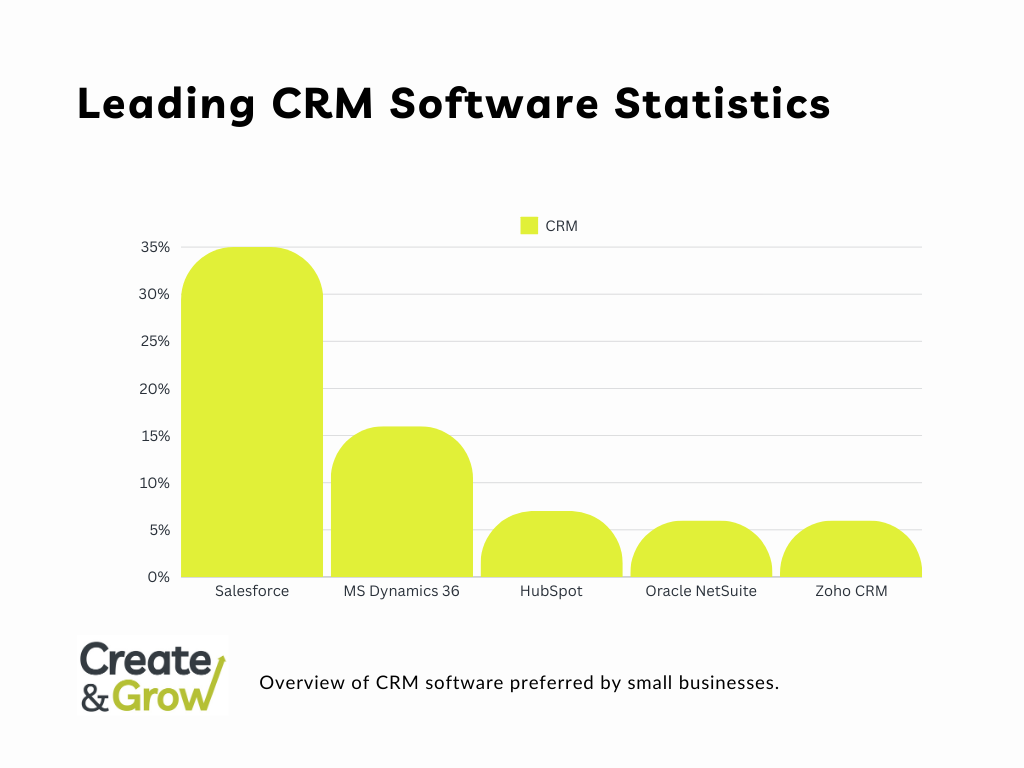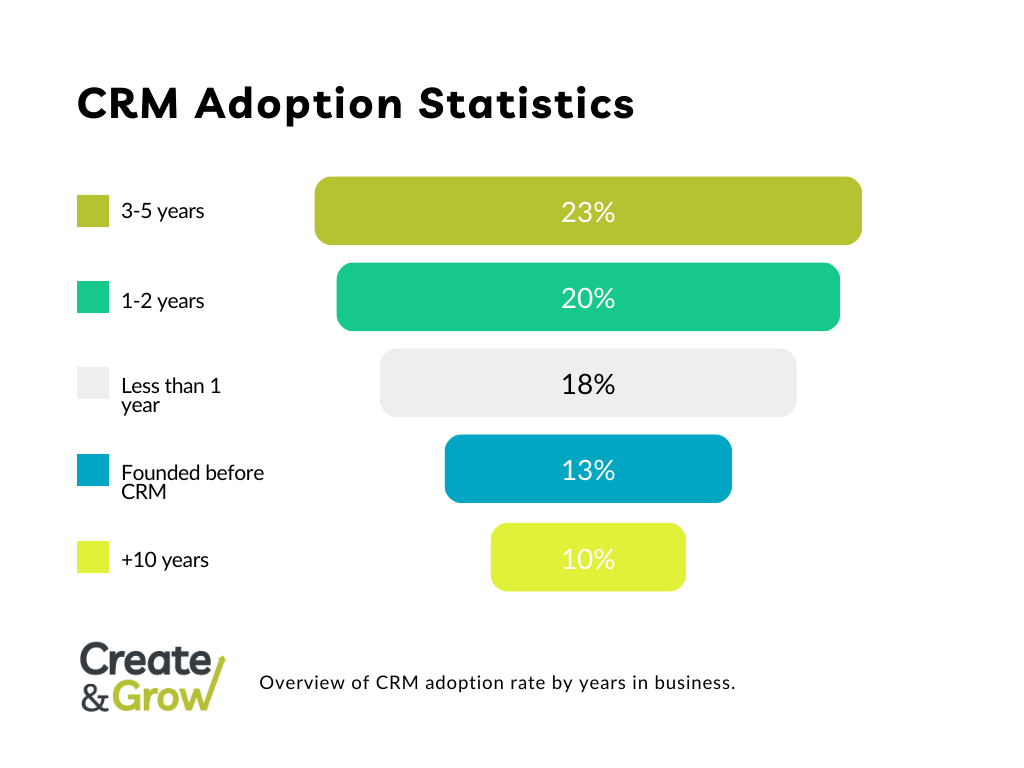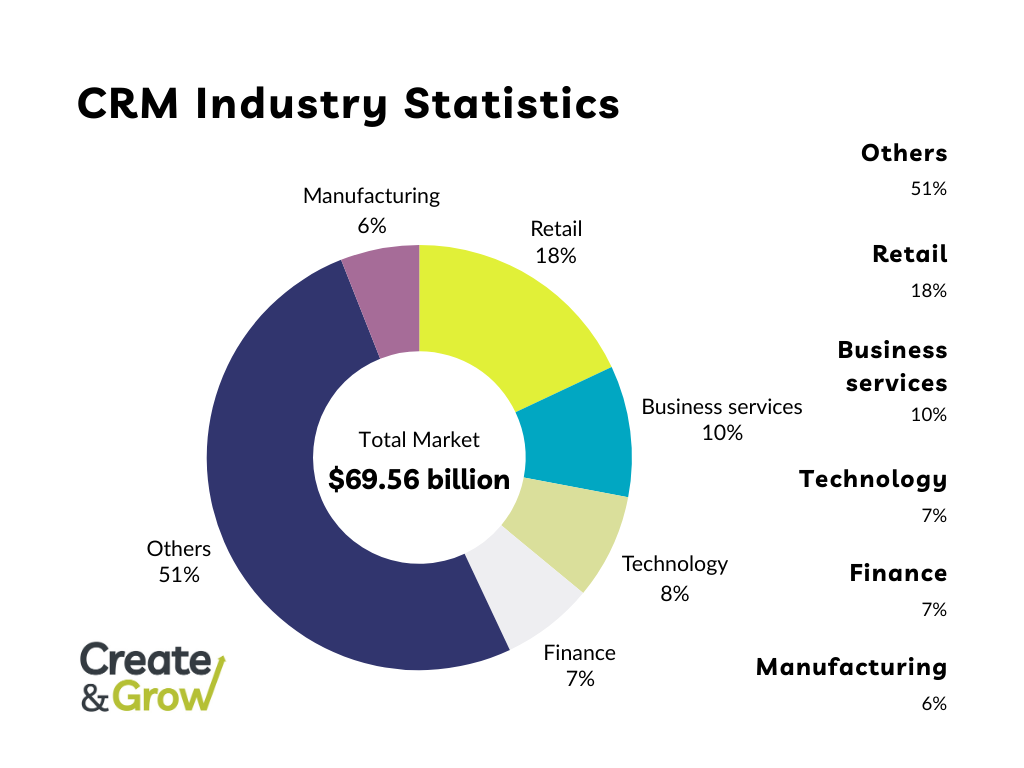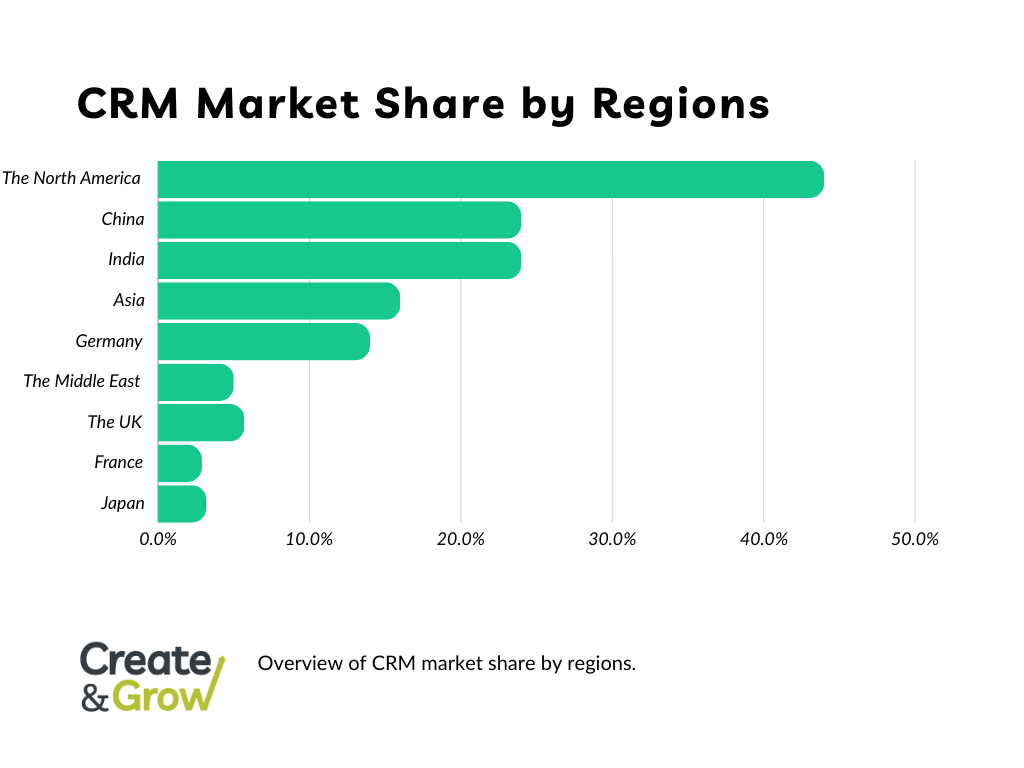General CRM Statistics
- With a remarkable 16% growth in 2018, CRM established itself as one of the fastest-growing software solutions, maintaining its market leadership through 2023 (Source: Pipeline CRM)
- In 2023, the global market size for customer relationship management (CRM) was assessed at USD 65.59 billion, and it is projected to exhibit a substantial compound annual growth rate (CAGR) of 13.9% from 2024 to 2030. (Source: Grand View Research)
- Within five years of establishing their businesses, 65% of companies have adopted CRM. (Source: Answeriq)
- The global CRM market is anticipated to experience a 12% CAGR between 2023 and 2030. (Source: Anweriq)
- As of 2023, the global CRM market is valued at $71 billion. (Source: Anweriq)
- Among survey respondents, 44% indicate that they will promptly decline a sales pitch if the sales representatives haven’t conducted comprehensive research on their company and specific requirements, whereas 33% view an excessive number of calls and emails as deal breakers. (Source: Pipeline CRM)
- A total of 77% of sales professionals report that their organization intends to increase investments in sales intelligence tools, which include CRM systems. (Source: Pipeline CRM)
- Research spanning nearly two decades by multiple analysts reveals that the failure rate of CRM projects falls within the range of 20-70%. (Source: Skuid)
- Merely 37% of sales representatives believe that their organization fully maximizes the potential of their CRM system. (Source: Salesforce)
- Presently, 25% of small to medium businesses have adopted CRMs, and an additional 10% of non-users are contemplating implementation. (Source: Business)
- Among organizations that have embraced CRMs, 61% have observed enhanced customer retention, while another 14% have noted a reduction in their cost per conversion. (Source: Business)
- For organizations utilizing CRMs, 32% identified the greatest challenge as a lack of expertise among users, underscoring the necessity for enhanced training programs. (Source: Business)
- When making a purchase, 79% of business buyers emphasize the importance of engaging with a salesperson they consider a trusted advisor. (Source: Findstack)
- It is anticipated that 91% of the data stored in CRM systems will be either incomplete, outdated, or duplicated annually. (Source: Findstack)
- The top priority for 74% of companies is the conversion of leads into loyal customers. (Source: Findstack)
- The leading CRMs preferred by small businesses are as follows: Salesforce (35%), Microsoft Dynamics 365 Sales (16%), Hubspot (7%), Oracle NetSuite (CRM) (6%), and Zoho CRM (6%). (Source: Business)

CRM Adoption Statistics
- A mere 40% of businesses report achieving a CRM adoption rate of 90%, with the majority of businesses facing challenges in promoting system adoption. (Source: G2)
- The usage of CRM software from multiple devices has risen to 81% among users. (Source: SuperOffice)
- CRM software is at the forefront of this technology investment trend, as 44% of businesses intend to boost their IT budgets in 2023, an increase from 38% in 2022. (Source: SuperOffice)
- Small businesses are also joining in, as 50% of companies with fewer than 50 employees are embracing CRM solutions. (Source: Five CRM)
- In the present day, 65% of businesses that have embraced mobile CRM have successfully met their sales targets, in contrast to only 22% of businesses that do not utilize mobile CRM. (Source: Five CRM)
- A total of 83% of senior executives have indicated that their primary challenge lies in encouraging their staff to utilize the software. (Source: Nomalys)
- 23% of companies implemented CRM within 3 to 5 years of founding, with 20% adopting it within 1 to 2 years, and 18% within less than 1 year; meanwhile, 13% were established prior to CRM adoption, 10% adopted CRM between six to ten years, and another 10% after more than ten years. (Source: Zippia)
- Within the first year, 18% of businesses implement CRM, while 1 in 5 companies (20%) adopt CRM between one and two years. (Source: Demand Sage)
- Companies that are early adopters of sales automation consistently experience higher customer-facing time, increased customer satisfaction, efficiency enhancements of 10 to 15%, and the potential for sales uplift of up to 10%. (Source: Sugar CRM)

CRM User and Usage Statistics
- CRM systems are employed by 91% of companies with more than 11 employees. (Source: Demand Sage)
- Approximately 82% of businesses utilize CRM for sales reporting. (Source: Demand Sage)
- A total of 54% of sales professionals leverage CRM to foster stronger relationships with their buyers. (Source: Demand Sage)
- Among salespeople, those utilizing mobile CRM achieve their sales quotas at a rate of 65%, while only 22% of those not using mobile CRM do so. (Source: Zippia)
- Sales representatives allocate 17.9% of their working hours to CRM activities. (Source: Zippia)
- A significant 94% of users express the desire for contact management features in their CRM platform, while 88% of users seek interaction tracking capabilities in their CRM platform. (Source: WebFX)
- Approximately 54% of sales professionals depend on sales tools such as CRM to cultivate stronger relationships with buyers, ultimately leading to an increase in closed deals. (Source: Pipeline CRM)
- In CRM automation, priorities span from lead nurturing at 57% to customer engagement at 36%, and campaign reporting at 28%, emphasizing the multifaceted role of automation in enhancing various sales aspects. (Source: Pipeline CRM)
- The real estate sector leads CRM purchases at 18%, with business services at 10%, technology at 8%, finance at 7%, manufacturing at 6%, and other sectors collectively at 51%. (Source: Zippia)
- Sales teams that are effective are 81% more likely to demonstrate consistent usage of CRM systems. (Source: Adynamics)
- A striking 90% of customers anticipate consistency and seamless experiences across various channels. (Source: Adynamics)
- Furthermore, 75% of customers expect customer service agents to possess knowledge of their prior product purchases and service history. (Source: Adynamics)
- Implementing sales automation can lead to improved customer satisfaction and a potential revenue increase of up to 5%. (Source: Sugar CRM)
- A significant 76% of respondents express their primary frustration with CRM being its complexity, lack of user-friendliness, or the inability to customize it to their needs. (Source: Sugar CRM)

CRM Benefits Statistics
- Companies utilizing CRM have witnessed a 27% boost in customer retention rates. Additionally, 73% of businesses have reported enhanced customer relationships following the implementation of a CRM system. (Source: Five CRM)
- CRM technology’s enhanced data accessibility can typically streamline the sales cycle by 8-14%, and decision-makers report a 14.6% productivity boost with the use of social and mobile CRM. (Source: Findstack)
- According to Salesforce research, CRM software has the potential to boost sales by up to 29%, enhance sales forecasting accuracy by as much as 32%, and increase sales productivity by 39%. (Source: Findstack)
- According to the HubSpot State of Marketing report, 75% of companies consider closing more deals for their teams increasingly important, with 48% aiming to enhance the efficiency of their sales funnels. (Source: Findstack)
CRM Customer Experience Statistics
- A total of 47% affirm that it enhances customer satisfaction, typically resulting in improved customer retention, while 45% assert that it boosts sales revenue and 39% state that it enhances their success in upselling and cross-selling. (Source: Zippia)
- A significant 66% of customers anticipate companies to have an understanding of their needs. (Souce: HubSpot)
- Companies that prioritize customer-centric approaches are found to be 60% more profitable than those that do not prioritize customers. (Source: HubSpot)
- Research indicates that in nearly every industry, 25% of customers are willing to pay up to 10% more when assured of receiving outstanding customer service. (Source: HubSpot)
- With 70% of consumers indicating a strong inclination to exclusively buy from brands that comprehend their needs, prioritizing personalization in your business strategy can yield significant benefits. (Source: HubSpot)
- A majority of 60% of consumers have chosen to purchase from one brand instead of another, primarily influenced by the service they anticipate receiving. (Source: Zendesk)
- Moreover, 64% of customers are willing to increase their spending if a business resolves their issues on the platform or location where they initially contacted the company. (Source: Zendesk)
CRM Sales Statistics
- A properly executed CRM system can yield a return on investment of $45 for every $1 invested. (Source: Salesmate)
- The CRM industry is projected to surpass a valuation of over $88 billion by the year 2024. (Source: Demand Sage)
- The revenue is expected to exhibit a compound annual growth rate (CAGR) of 10.59% from 2024 to 2028, resulting in a market size of $131.90 billion by 2028. (Source: Demand Sage)
- The revenue within the CRM Software market is expected to achieve a value of US$88.19 billion by the year 2024. (Source: Statista)
- The projected average Spend per Employee within the Customer Relationship Management Software market is forecasted to reach US$25.14 in 2024. (Source: Statista)
- When implemented correctly, a CRM software system can deliver an ROI that surpasses 245%. (Source: tech.co)
- The typical ROI for every dollar invested in CRM stands at $8.71. (Source: truelist.co)
CRM Market Share Statistics
- In 2023, the North American region held a leading position in the CRM market, commanding 44% of the market share. (Source: Answeriq)
- In 2023, the U.K. CRM market was valued at approximately USD 3,725.1 million. (Source: Grand View Research)
- The German CRM market was anticipated to exhibit a CAGR of roughly 14% throughout the forecast period. (Source: Grand View Research)
- France’s CRM market had an estimated value of USD 1,885.2 million in 2023. (Source: Grand View Research)
- The Asia Pacific region is poised to emerge as the fastest-growing regional market, with an expected CAGR of 15.6% during the forecast period. (Source: Grand View Research)
- China’s CRM market was projected to capture a 24% market share within the Asia Pacific CRM market in 2023. (Source: Grand View Research)
- In 2023, India’s CRM market was forecasted to hold a 24% market share within the Asia-Pacific CRM market. (Source: Grand View Research)
- Japan’s CRM market was valued at around USD 2,120.6 million in 2023. (Source: Grand View Research)
- The Middle East & Africa CRM market was expected to have a 5% market share in 2023. (Source: Grand View Research)
- By 2027, an estimated 50,000 Saudi nationals are set to receive training and certification in cutting-edge cloud-based digital technologies, including artificial intelligence, machine learning, and the Internet of Things (IoT). (Source: Grand View Research)
- The CRM market has experienced significant growth in recent years, expanding by $22 billion in the past three years, and is projected to increase by nearly $30 million in the coming three years. (Source: Demand Sage)

CRM Software Statistics
- CRM software has currently become the largest software market globally, and its growth shows no signs of deceleration. It is anticipated that CRM will achieve revenues exceeding $80 billion by the year 2025. (Source: SuperOffice)
- The global customer relationship management (CRM) software market is predicted to reach a size of $57 billion in 2025, marking a projected growth of nearly $4 billion from 2021, with a compound annual growth rate (CAGR) of 2.1 percent. (Source: Statista)
Frequently Asked Questions

